
Antarctic Legacy Archive
Long-term niche fidelity in southern elephant seals: do individuals display unique foraging strategies?
- ALSA Home
- →
- Documents
- →
- Research Events
- →
- View Item
JavaScript is disabled for your browser. Some features of this site may not work without it.
| dc.contributor.author | McIntyre, T. | |
| dc.contributor.author | Bornemann, H. | |
| dc.contributor.author | De Bruyn, P.J.N. | |
| dc.contributor.author | Tosh, C.A. | |
| dc.contributor.author | Bester, M.N. | |
| dc.coverage.spatial | sub-Antarctic | |
| dc.coverage.spatial | Marion Island | |
| dc.date.accessioned | 2021-03-10T14:47:02Z | |
| dc.date.available | 2021-03-10T14:47:02Z | |
| dc.date.created | 2016/07/27 | |
| dc.date.issued | 2016/07/27 | |
| dc.identifier.uri | http://hdl.handle.net/123456789/28629 | |
| dc.description.abstract | Fidelity to foraging sites and foraging strategies is potentially beneficial to individuals using habitats with patchily distributed resources, as in a number of marine mammal species. We assessed interannual and long term (up to eight year) patterns in the spatial distribution and diving strategies used by southern elephant seals (Mirounga leonina) from sub-Antarctic Marion Island, instrumented with satellite-relay data loggers over multiple foraging migrations. We calculated inter-annual three dimensional (3D) kernel density (KD) range overlaps for seals tracked over at least two post-moult foraging migrations in order to assess overlap for both the water depths and temperatures targeted during foraging migrations. We used intra-class correlation coefficients from linear mixed effects models to calculate intra- and inter-individual variance for a series of track- and dive metrics. A repeatability index was ultimately derived for individual metrics, where higher values (between 0.5 and 1) indicate individually unique consistent behaviours, since greater variance occurs between, and not within, individual behaviours. Individual seals displayed high levels of fidelity to vertical depth layers where mean overlap for 95% 3D KO home range estimates were 52.6% (inter-annual) and 34.3% (multi-year). Similarly, high levels of fidelity to temperature zones were evident where mean overlap for 95% 3D KD home range estimates were 48% (inter-annual) and 35% (multi-year). Repeatability index values ranged between 0.38 and 0.57 for all metrics tested, indicating that the variance between individuals tested was generally not substantially more than within individuals. This study is the first to show that southern elephant seals display high levels of foraging niche fidelity in terms of spatial areas used, vertical depth layers targeted, as well as preferred in situ thermal conditions. Such observed inter-migration stability in habitat use patterns likely confers long-term energetic advantages to individual seals, despite little evidence for individually unique behaviours between these seals. While previous studies suggested likely inter-sex and inter-age class avoidance of intra-specific competition in southern elephant seals, the apparent lack of individually-unique foraging strategies reported here indicates that there is little individual-level avoidance of intra-specific competition. | en_ZA |
| dc.description.sponsorship | Sponsored by the the Department of Science and Innovation(DSI) through National Research Foundation (NRF) - South Africa | en_ZA |
| dc.description.statementofresponsibility | Antarctic Legacy of South Africa | en_ZA |
| dc.format | en_ZA | |
| dc.language | English | en_ZA |
| dc.publisher | South African National Antarctic Programme (SANAP) | en_ZA |
| dc.relation | SANAP Symposium 2016 | en_ZA |
| dc.rights | Copyright | en_ZA |
| dc.subject | Research | en_ZA |
| dc.subject | Science | en_ZA |
| dc.subject | Meetings | en_ZA |
| dc.subject | Symposium | en_ZA |
| dc.subject | SANAP Symposium 2016 | en_ZA |
| dc.subject | Marion Island | en_ZA |
| dc.subject | Terrestrial Science | en_ZA |
| dc.subject | Living Systems | en_ZA |
| dc.subject | Research | en_ZA |
| dc.subject | Zoology | en_ZA |
| dc.subject | Fauna | en_ZA |
| dc.subject | Mammalogy | en_ZA |
| dc.subject | Mammals | en_ZA |
| dc.subject | Seals | en_ZA |
| dc.subject | Elephant Seals | en_ZA |
| dc.subject | Biological sciences | en_ZA |
| dc.title | Long-term niche fidelity in southern elephant seals: do individuals display unique foraging strategies? | en_ZA |
| dc.type | Presentation-Abstracts | en_ZA |
| dc.rights.holder | Antarctic Legacy of South Africa | en_ZA |
| dc.rights.holder | McIntyre, T. | en_ZA |
| dc.rights.holder | Bornemann, H. | en_ZA |
| dc.rights.holder | De Bruyn, P.J.N. | en_ZA |
| dc.rights.holder | Tosh, C.A. | en_ZA |
| dc.rights.holder | Bester, M.N. | en_ZA |
| iso19115.mdconstraints.uselimitation | This item and the content of this website are subject to copyright protection. Reproduction of the content, or any part of it, other than for research, academic or non-commercial use is prohibited without prior consent from the copyright holder. | en_ZA |
| iso19115.mddistributor.distributorcontact | South African National Antarctic Programme (SANAP) | en_ZA |
| iso19115.mdformat.name | en_ZA | |
| iso19115.mdidentification.deliverypoint | Antarctic Legacy of South Africa, Faculty of Science, Private Bag X1, Matieland. Stellenbosch. South Africa. | en_ZA |
| iso19115.mdidentification.electronicmailaddress | antarcticlegacy@sun.ac.za | en_ZA |
| iso19115.mdidentification.organizationname | University of Pretoria | en_ZA |
| iso19115.mdidentification.organizationname | Alfred Wegener lnstitut | en_ZA |
Files in this item
This item appears in the following Collection(s)
-
Research Events [502]
Material directly related to official scientific and research events
